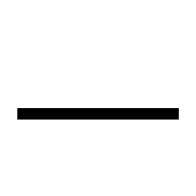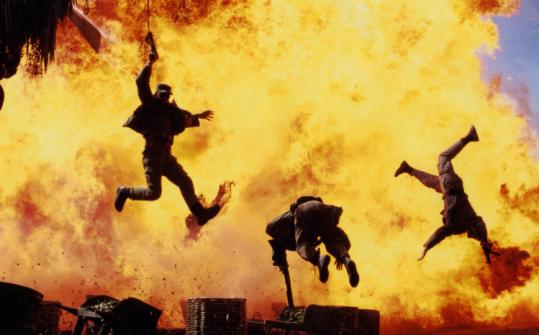— (Em Dash)
 This is the most complicated image ever presented on the Black Gate website.
This is the most complicated image ever presented on the Black Gate website.
A few days after I posted my article on the use of semicolons in fiction, I was at a writers’ group meeting and brought up the subject of the contentious punctuation mark. When I expressed my enjoyment of semicolons, one of the other writers present at the library table asked the most appropriate follow-up question:
“How do you feel about em dashes?”
Terrific query. Answer: I love ‘em. Many uses, wonderful informality, a real rhythm-maker. Great way to smash the cymbals on your drum set in the middle of a jazz riff. My major caveat about the em dash is that if overused, it draws enormous visual attention to itself that no reader can miss; the em dash is the most immediately obvious character on a page, and a slew of them is visible with a single glance. You know how annoying a long drum solo can get.
Getting down to defining terms, the “em dash” is the longest of the three horizontal lines that most fiction writers use. (There are more horizontal lines if the topic is mathematics. I barely got through math in high school so I will not bother with it any further here.) The “Dashes Three” are the hyphen (-), the en dash (–), and the em dash (—). On Mac keyboards the same key creates all three, the one hanging out casually between “0” and “=” in the upper right quadrant. Press the key on its own, you get the hyphen. Combining it with “Option” gets you the en dash, and the triple strike with “Option” and “Shift” creates the em dash. Monospace typographic convention considers two hyphens (“–”) to be an em dash. Microsoft Word’s default settings automatically corrects two hyphens into an em dash. In fact, I had to turn that function temporarily off so I could create those two hyphens without the program pulling out the digital birch rod and correcting me.
The function of the hyphen is primarily grammatical: compound words, compound modifiers, and indicating prefixes. Newer dictionaries are going after the use of hyphens in compound words with intent to kill, knocking more and more out of the lexicon each year in favor of either leaving a space between the words or pushing the two words together in true Teutonic synthesis.
The en dash has an extremely specific use: indicating a numeric range. Writers will principally use this for dates. Okay, tombstones. “Agnes Jones. 1888–1950. God Have Mercy on Her Soul, Because None of the Rest of Us Could Stand Her.” Most writers use a hyphen instead an en dash, and readers rarely notice. I notice, but you may have picked up on my unhealthy fascination with typographic minutiae.
Ah, but the em dash! It’s a comma, it’s a parenthesis, it’s a colon, it’s an ellipses! It’s anything you want it to be, and more! In fact — and this is speaking from experience — the general use of the em dash is so — so — so variable and useful — that — well, it’s easy to use them — unlike semicolons — for almost — any — purpose whatsoever. What — so — ever! I would continue writing like this, if I were not rudely interrup —
(Note: Black Gate’s standard usage is for an “open em dash,” meaning spaces on both sides. I have followed suit on the posting. I personally favor closed em dashes — strongly favor — and that’s how they appear in my writing everywhere else other than Black Gate’s website.)
Strunk and White’s feelings on the em dash are more reserved, but Elements of Style tends toward a more conservative, academic use of grammar. The use of the “dash” (Elements of Style chooses not to confuse the general reader with the term “em dash”) is governed in Rule 9, Part II:
Use a dash to set off an abrupt break or interruption and to announce a long appositive or summary.
A dash is a mark of separation stronger than a common, less formal than a colon, more relaxed than parentheses, more powerful than a locomotive, able to leap tall buildings in a single bound. . . .
I added something there. It’s hard to find, I know.
Elements of Style provides a final caveat: “Use a dash only when a more common mark of punctuation seems inadequate.” Well, fortunately for fiction writers, there are many times when anything common seems inadequate. Fire away, em dashes!
Here is how I interpret this everyman/woman of the punctuation world: the em dash has the reverse issue of the semicolon. The semicolon has a more defined use, and finds a greater comfort zone in nonfiction. The em dash is much less at home in nonfiction, but can go berserk in fiction because it can fill in any spot where the writer wants to create the sense of a break that will grab the reader’s eye. It is almost unfettered by grammatical concerns.
That also means it can get abused without mercy. The visual nature of the em dash — it is difficult to miss, bowling over lowercase “i” if you’re reading fast — means the possibility of disruption on the page. No grammatical form is easier for a reader to detect in overuse. Even exclamation marks! After all, exclamation marks are thin! The only way for an exclamation mark to get more attention is to use more than three of them!!!!!!!! Or combine them with other forms of punctuation!?!
(I believe that, as the letters “t” and “z” in German eventually morphed into a single letter “ß,” one day typography will morph the frequent “exclamation mark + question mark” sequence into a single symbol, something called “the emphatic question mark.” I’d show you what I think it would look like, but I can’t find a way to insert it into my text because it hasn’t been invented yet. Why not?!)
As I did with semicolons, I’m going to turn to my own writing to see how I tend to use the em dash. There are two situations where I particularly like using them in fiction: as a substitute for parentheses, and in dialogue.
I love parentheses in nonfiction, and probably use them a bit too much. Look over any of my other posts at Black Gate and you’ll see a preponderance of the suckers. However, I dislike them in fiction, and avoid them whenever possible. The em dash serves a more natural flow in fiction, and so for any parenthetical break within a paragraph, I pull out the em dash to serve.
But it is in dialogue where I truly find that the em dash is a great pal. This is probably because my wariness of ellipses (“. . .”). My problem with ellipses is mechanical: they don’t break around the edges of pages well, unless you use the single-character ellipses (“Option + ;” on a Mac keyboard), which looks too crammed together. Also, I think of ellipses in their academic use more than anything else, where they indicate excision of material in a quotation. I do use ellipses in fiction, but sparingly so they have impact. They work well for a character’s dialogue trailing off, or at the end of a paragraph right before a major event intrudes. Usually something blowing up. I keep them stored in my writing arsenal for emergencies only. Usually something blowing up.
So the em dash does most of the work in my dialogue to indicate a character pausing, abruptly shifting an idea, introducing direct address in the middle of dialogue, or getting cut off by another speaker or something blowing up.
The danger of the em dash, as I mentioned before, is that overuse is immediately obvious to a reader. You can just glance at a page and see that a writer has had an em dash explosion, and it looks extremely distracting.
I scanned over a few pages of my novels and short stories to make sure that I was practicing what I preached. Although I know I love em dashes, and have an automatic finger reflex to create one using “Option-Shift,” I was pleased to see that no page had them leaping out in a horizontal ant swarm of visual aggravation.
And so, I would like to suggest —

Ryan Harvey is a veteran blogger for Black Gate and an award-winning science-fiction and fantasy author. He received the Writers of the Future Award in 2011 for his short story “An Acolyte of Black Spires,” and has two stories forthcoming in Black Gate and a number of ebooks on the way. He also knows Godzilla personally. You can keep up with him at his website, www.RyanHarveyWriter.com, and follow him on Twitter.
Does the Unicode character QUESTION EXCLAMATION MARK ⁈ count as “the emphatic question mark?” 🙂
I think for it to count it would have to have gone Germanic weird on us like ß. Which is a great letter that I wish we had.
The !?! you are looking for is called the interrobang.
http://en.wikipedia.org/wiki/Interrobang
I am a big fan of the em dash, though I just use a dash with spaces around it, because I am a neanderthal. I use ellipses to suggest the trailing off of words or a thought, and a double dash “–” to suggest the abrupt breaking of dialog or thought.
“But I thought a double dash was a–”
“Don’t interrupt,” he interrupted.
Like that.
Ha! It changes my two dashes into an em dash!
Ryan, I love these posts on punctuation marks. Punctuation’s such an overlooked part of writing — yet so important in the flow of dialogue and the structure of sentences. It’s great to see some discussion of such things.
And I think you’ve done an excellent job here laying out the different varieties of pause and use of the dash. Personally I feel the dash is somehow more dramatic than the ellipsis. At the end of dialogue it’s like a sudden stop, a crashing into a brick wall, as opposed to a leisurely trailing off, a slow running-out of gas. And in the middle of a sentence the link feels to me tighter, so that thoughts seem to co-exist or even overlap slightly.
(And for what it’s worth in re: the semicolon post — I like Vonnegut’s writing, but I like the semicolon much, much more.)
Lovely post!
Punctuation marks invoke the authors who’ve used them most—who can think of the em dash without remembering Emily Dickinson?—and the forms in which they most often appear—which is why the ellipsis, especially in dialogue, smells of the penny dreadfuls. I recently abandoned reading an epic fantasy/alternate history series I was otherwise enjoying because its authors overused the ellipsis whenever the villains were talking. Every time they did it, I had visions of a vaudeville performer’s rendition of Simon LeGree, complete with twisting moustachios—problematic, since the story was sort of set during the Renaissance. It’s the only time I’ve abandoned a book over punctuation that was not technically in error.
Okay, that decides it. Next post will be titled “. . .”
“Can . . . you . . . dig . . . it?”
or
“Can — you — dig — it?”
[…] on from the em dash (—), my series on punctuation continues with a post guaranteed to leave you […]